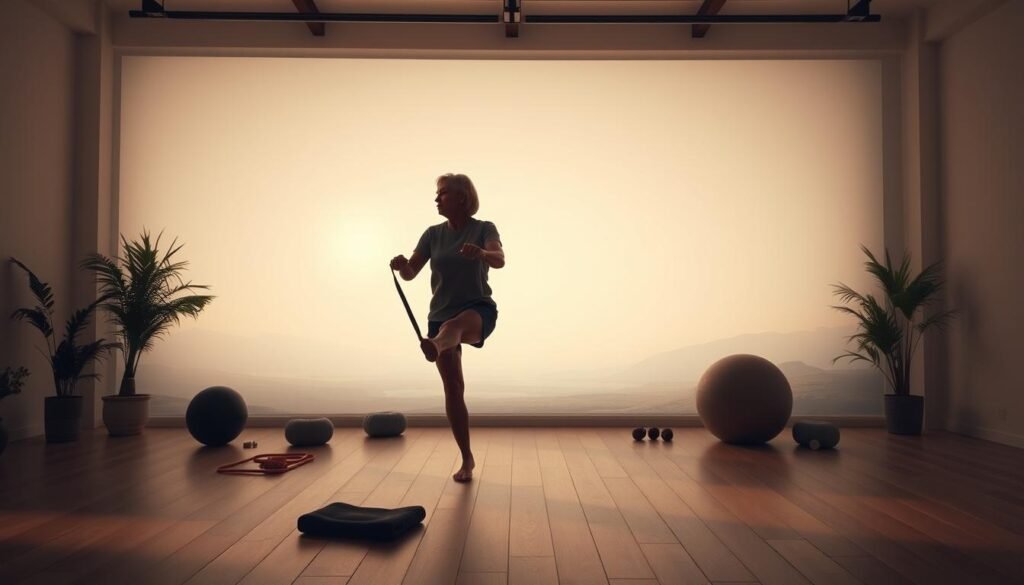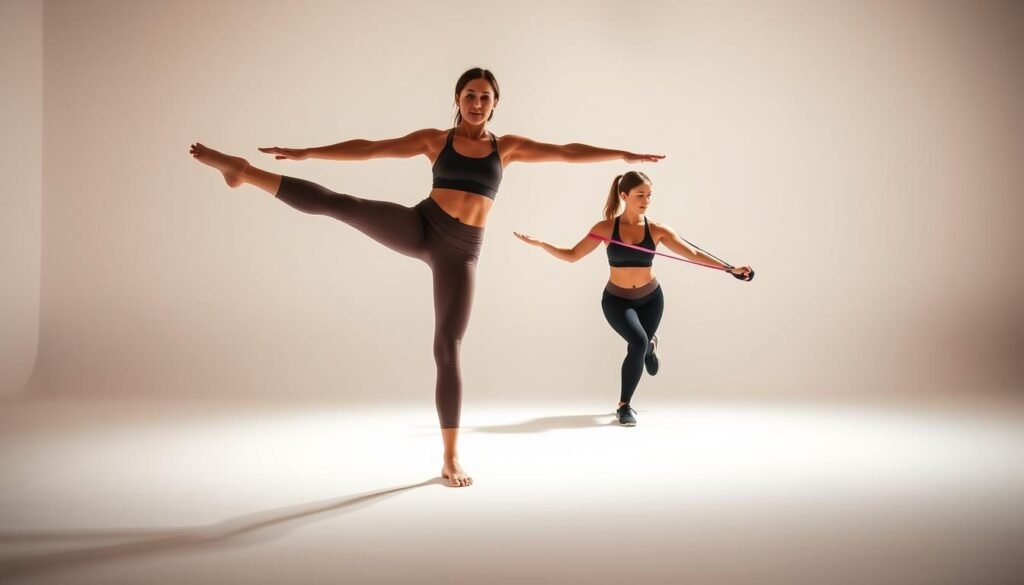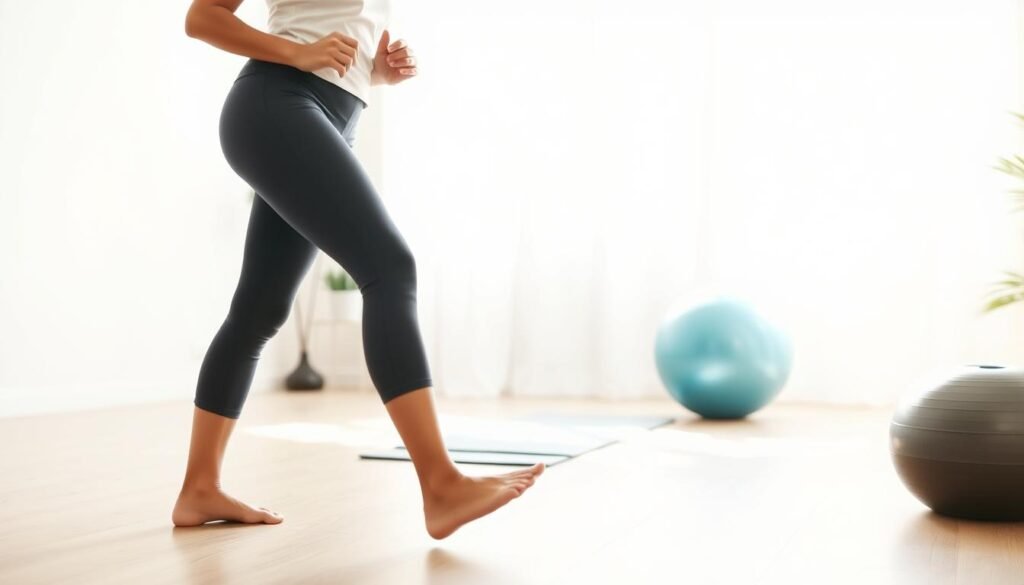
When joints ache, sitting still often feels like the only option. But what if gentle movement could become your most powerful tool against discomfort? For those navigating arthritis-related knee challenges, targeted physical activity isn’t just safe – it’s essential for maintaining mobility and reducing stiffness.
Research shows that strategic movements strengthen muscles around joints, acting like natural shock absorbers. Our guide explores how specific low-impact aerobic activities and strengthening routines can improve stability while protecting sensitive areas. We’ll break down why complete rest often worsens symptoms, and how controlled motion helps lubricate joints.
You’ll discover methods backed by physical therapists and pain management specialists, including:
• Water-based workouts that reduce pressure on joints
• Muscle-building sequences that protect knee cartilage
• Daily movement strategies to prevent stiffness flare-ups
Contrary to popular belief, consistent activity helps maintain range of motion better than avoidance. We’ve combined clinical insights with practical modifications to help you move confidently. Whether dealing with osteoarthritis or other forms of joint inflammation, our step-by-step approach addresses both immediate relief and long-term joint health.
Key Takeaways
- Movement combats arthritis stiffness better than prolonged rest
- Water exercises reduce joint impact by up to 50% compared to land activities
- Strong thigh muscles absorb 20-30% of knee stress during movement
- Daily flexibility routines prevent painful flare-ups
- Expert-designed programs balance safety with effectiveness
Understanding Knee Arthritis and Its Impact
Arthritis in the knees doesn’t just cause discomfort—it reshapes how we move through daily life. Morning stiffness often lingers, making routine tasks like climbing stairs or standing up feel exhausting. Over time, this can lead to compensatory movements that strain other body areas.
Symptoms and Daily Challenges
Persistent pain ranks as the most reported symptom, often worsening after periods of inactivity. Many individuals unknowingly shift weight to one leg to avoid discomfort, creating muscle imbalances. Keeping a leg straight for prolonged periods—common during desk work—can accelerate joint stiffness.
These adaptations don’t just affect knees. Compromised movement patterns transfer stress to the back and hips, triggering secondary discomfort. Simple acts like bending to tie shoes or carrying groceries become challenging puzzles requiring strategic planning.
Why Strengthening Matters
Building muscles around joints acts like biological armor. Quadriceps and hamstrings absorb impact that would otherwise grind cartilage. A study from the Arthritis Foundation reveals patients who strengthened these areas reported 40% less pain during walking.
Targeted training also corrects imbalances caused by favoring one leg. When muscles regain equal strength, pressure distributes evenly across both knees. This reduces wear patterns that accelerate degeneration—proving that smart movement truly is medicine.
Why Exercise is Crucial for Joint Health
Joint health thrives on motion, not stagnation. Research reveals that structured physical activity serves as both immediate relief and future protection for vulnerable areas. Unlike temporary fixes, movement addresses root causes by enhancing biological systems that cushion and stabilize.

Unlocking Freedom Through Stability
Building strength in key muscle groups transforms how bodies handle pressure. A 2023 Johns Hopkins study found participants who strengthened their hips and thighs experienced:
- 34% reduction in knee discomfort during walking
- Improved balance scores correlating with fewer falls
- Enhanced ability to rise from chairs without assistance
These improvements stem from muscles absorbing shock that would otherwise batter vulnerable joints. Physical therapists often compare this process to “building living braces” through controlled movement.
Sustaining Mobility Across Decades
Consistent activity doesn’t just ease today’s stiffness—it safeguards tomorrow’s flexibility. The Arthritis Foundation notes:
“Patients maintaining strength routines for 6+ months show 50% slower cartilage deterioration compared to sedentary peers.”
This protective effect extends to surrounding structures. Strong hip flexors and core muscles redistribute weight during walking, preventing excessive knee strain. Our joint support strategies emphasize this whole-body approach, recognizing how balance in one area supports others.
Regular movement also stimulates synovial fluid production—nature’s joint lubricant. This biological process explains why morning stiffness eases after gentle activity, creating a self-reinforcing cycle of comfort and capability.
Best Exercise for Arthritic Knees: Expert Recommendations
Movement becomes medicine when precision meets purpose. Physical therapists like Jay Milomo emphasize that proper technique transforms simple motions into joint-protecting strategies. Let’s explore foundational movements recommended by arthritis specialists.
Mastering Straight-Leg Raises
Begin seated or lying flat. Engage thigh muscles as you lift one lower leg until it’s parallel to the floor. Milomo advises:
“Hold position for 15 seconds – long enough to activate stabilizers, short enough to prevent strain.”
Repeat 8-10 times per leg. Those with limited mobility can use chair support:
- Place hands under thighs for assisted lifts
- Focus on controlled upward motion
- Lower leg gradually using muscle resistance
Strategic Stretching Sequences
Improve flexibility while protecting joints. Sit on the floor with legs extended. Slowly bend forward at hips until you feel stretch in hamstrings. Rheumatoid arthritis experts recommend:
- Maintain each stretch 20-30 seconds
- Keep back straight to avoid compensation
- Use yoga straps for modified reaches
For standing variations, place one foot on a low step. Slowly bend the opposite knee while keeping your straight leg firmly planted. This dual-action movement builds stability while allowing you to feel stretch in tight areas.
Low-Impact Exercise Options and Modifications
Movement becomes your natural ally when joints need protection. Discover activities that maintain mobility while respecting your body’s limits. These approaches combine therapeutic benefits with adaptable intensity levels.

Water Aerobics and Cycling for Reduced Strain
Water’s buoyancy transforms workouts. It supports 90% of body weight, easing pressure on the foot and legs. Try these variations:
- March in chest-deep water while swinging arms
- Use pool noodles for resistance without joint stress
- Perform side-to-side steps to engage inner thigh muscles
Stationary cycling offers similar advantages. Adjust seat height so your legs maintain slight bends at the pedal’s lowest point. Physical therapist Laura Hernandez notes:
“Three 15-minute sessions weekly improve circulation while protecting cartilage.”
Simple Home-Based Routines
Create effective workouts without specialized equipment. Try this sequence:
| Activity | Benefits | Modifications |
|---|---|---|
| Seated leg lifts | Strengthens thigh without floor impact | Use ankle weights for progression |
| Side-lying leg raises | Targets outer hip stabilizers | Place hand on floor for balance |
| Wall sits | Builds endurance safely | Adjust sliding depth based on comfort |
Positioning matters. When standing, distribute weight evenly between both legs. Use a chair’s armrests for support during side reaches. For floor exercises, kneel on cushioned mats to protect joints.
Focus on controlled movements rather than speed. Engage your arms as counterbalances during single-leg stands. These strategies help maintain stability while progressively building strength.
Exercises Demonstrated by Health Professionals
Health professionals reveal how precise movements can alleviate knee discomfort effectively. Their demonstrations combine stability training with adaptive techniques tailored for varying mobility levels. This approach transforms ordinary chairs into tools for building strength safely.
Insights from Physiotherapists and Arthritis Foundations
Leading experts emphasize three core principles for chair-assisted workouts:
- Maintain neutral spine position during seated movements
- Hold stretches for 20-30 seconds to improve tissue elasticity
- Repeat sequences 8-10 times per session for muscle memory
Physical therapist Dr. Elena Torres explains:
“Facing the front of your chair ensures proper alignment. We teach patients to press palms against the seat while lifting legs – this engages core muscles without knee strain.”
Try this foundational routine shown in Arthritis Foundation videos:
| Movement | Duration | Key Focus |
|---|---|---|
| Seated marches | 45 seconds | Hip flexor activation |
| Supported squats | 12 times | Thigh strength |
| Side leg extensions | Hold 15 seconds | Outer hip stability |
For standing variations, position the chair slightly behind you. Lower into a partial sit position 5-7 times, using armrests for controlled descents. This front-facing technique builds confidence in weight transfer while protecting vulnerable areas.
Incorporating Movement into Daily Life
Small movements scattered throughout the day can transform joint health. We focus on practical strategies that fit naturally into existing routines, turning ordinary moments into opportunities for knee support.
From Sit-to-Stand to Daily Walks
Chair transitions become strength-building exercises when done mindfully. Place both hands on armrests and lean slightly forward. Push through your hips rather than knees when rising – this protects cartilage while engaging core muscles.
| Technique | Frequency | Key Tip |
|---|---|---|
| Sit-to-stand | 5-8 times/hour | Keep chest lifted |
| Stair stepping | 2 minutes 3x/day | Use railing for balance |
| Kitchen counter lifts | While waiting | Press hands downward |
Short walks after meals combat stiffness effectively. Even 7-minute strolls help circulate synovial fluid – nature’s joint lubricant. Those with limited time can break activity into 3-minute segments every 2 hours.
Use your environment creatively. When reaching high shelves, engage your chest muscles instead of overextending knees. While seated, rotate ankles clockwise for 30 seconds to maintain mobility. These micro-movements accumulate throughout the day, reducing flare-up risks.
Consistency matters more than duration. Set phone reminders every 90 minutes to shift positions. Physical therapist Mara Chen notes:
“Frequent positional changes prevent fluid from pooling in joints – think of it as ‘hydration through motion’.”
Tips for a Safe and Effective Exercise Routine
Safety transforms exercise from a challenge into sustainable relief. Proper technique and self-awareness allow you to reap benefits while protecting vulnerable areas. Let’s explore how to balance effort with joint preservation.
Maintaining Proper Form and Pace
Alignment matters most during stretch sequences. Keep your feet parallel and hip-width apart to distribute weight evenly. Physical therapist Dr. Rachel Kim advises:
“Imagine drawing energy up through your arches – this activates stabilizing muscles before movement begins.”
Start with shorter sessions (5-7 minutes) and gradually increase duration. Those managing osteoarthritis should:
- Bend knees no deeper than 45 degrees during squats
- Place hands on hips to monitor pelvic alignment
- Pause if you feel tension radiating beyond the knee
Recognizing Warning Signs and When to Rest
Discomfort lasting over 2 hours post-activity signals overexertion. Adjust routines if you experience:
| Warning Sign | Adjustment |
|---|---|
| Swelling around feet or ankles | Elevate legs with ice packs |
| Sharp knee pain during rotation | Switch to seated exercises |
| Morning stiffness exceeding 30 minutes | Reduce resistance levels |
Water-based activities offer natural joint relief when land exercises feel taxing. Try aquatic leg swings or shallow-end lunges 2-3 times weekly. Always exit the pool if you feel chilled – cold can intensify osteoarthritis stiffness.
Rest days are progress days. Alternate strength training with gentle stretch sessions to let tissues recover. Track symptoms in a journal to identify patterns and celebrate small victories in mobility.
Conclusion
Effective relief from arthritis symptoms isn’t found in stillness but in purposeful motion. The techniques we’ve explored—from water workouts to chair-assisted routines—strengthen support muscles while minimizing joint stress. Proper alignment proves critical: keeping back straight during lifts and stretches prevents compensatory problems in hips and spine.
Subtle adjustments make surprising differences. Positioning toes slightly outward during leg raises better engages the hamstring and buttocks. These muscle groups stabilize knees like natural shock absorbers. Consistency trumps intensity—short daily sessions yield better results than occasional pushes.
As you integrate these strategies, track small victories like reduced morning stiffness. Pair physical efforts with rest cycles for balanced care. Our joints thrive when we honor both movement and recovery, proving that mindful action unlocks lasting mobility.
